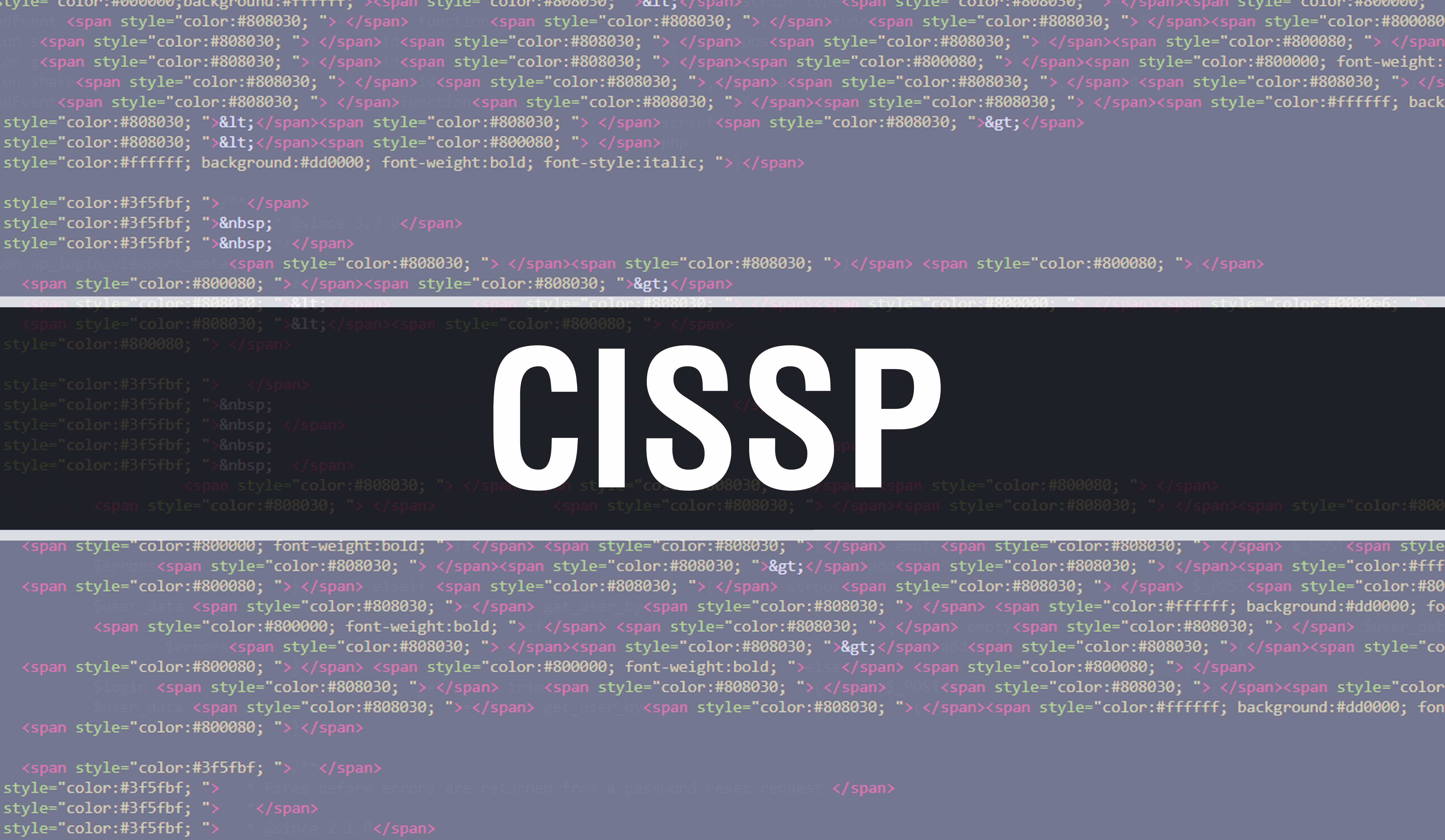
Embarking on the journey of studying for CISSP certification signifies a crucial step towards becoming a highly qualified cybersecurity professional. This globally recognized credential validates an individual’s comprehensive understanding of information security across various domains. While the value of obtaining the CISSP is undeniable, the exam itself is renowned for its challenging nature.
To achieve success and unlock the rewarding career opportunities associated with this certification, effective preparation is paramount. This guide will serve as your roadmap to navigating the CISSP exam, providing insights into its benefits, target audience, and most importantly, the crucial strategies to conquer its challenges and step confidently into the realm of cybersecurity expertise.
Understanding the CISSP Exam: Structure, Validation, and Preparation
The CISSP exam is a computerized adaptive test (CAT), meaning the difficulty of subsequent questions adapts based on your performance on previous questions. It encompasses 100-150 multiple-choice questions, with a passing score of 700 out of a possible 1000 points. The exam covers a broad spectrum of cybersecurity knowledge across eight domains:
- Security and Risk Management: Assessing risks, implementing security controls, and creating security policies.
- Asset Security: Protecting hardware, software, data, and information assets.
- Security Architecture and Engineering: Designing and implementing secure systems and infrastructure.
- Communication and Network Security: Securing communication channels and networks.
- Identity and Access Management (IAM): Controlling access to resources and managing user identities.
- Security Assessment and Testing: Identifying and analyzing vulnerabilities in systems and networks.
- Security Operations: Detecting, responding to, and recovering from security incidents.
- Software Development Security: Integrating security practices throughout the entire software development lifecycle.
Importance of CISSP Certification in Validating Cybersecurity Expertise
The CISSP certification serves as a highly respected and recognized validation of an individual’s proficiency in cybersecurity. Holding this credential demonstrates to employers and peers your deep understanding of security principles, best practices, and frameworks. It can significantly enhance your career prospects by:
- Opening doors to new job opportunities in various industries, including government, healthcare, finance, and technology.
- Commanding higher salaries compared to non-certified professionals.
- Boosting your credibility and reputation within the cybersecurity community.
Setting Realistic Expectations for CISSP Exam Preparation
The CISSP exam is intentionally challenging, requiring dedicated commitment and strategic preparation. It’s crucial to set realistic expectations to avoid discouragement and ensure a successful test experience:
- Allocate sufficient time: Depending on your prior knowledge and experience, aim for 3-6 months of dedicated studying.
- Utilize diverse learning resources: Combine study guides, practice tests, online courses, and professional development opportunities.
- Practice consistently: Regularly engage in practice tests and review your results to identify and address knowledge gaps.
- Seek support and guidance: Join online communities, connect with other CISSP aspirants, and consider seeking mentorship from experienced professionals.
By understanding the structure, value, and realistic preparation demands of the CISSP exam, you can increase your chances of successfully navigating this challenge and achieving your goal of becoming a certified cybersecurity professional.
Creating a Study Plan: Studying for CISSP with Strategy
Before diving into specific study materials, it’s vital to gain a clear picture of your current knowledge across the eight CISSP domains. This self-assessment helps you prioritize your learning efforts and allocate study time efficiently:
- Take domain-specific practice tests or quizzes.
- Review official CISSP resources like the CBK (Common Body of Knowledge) outline and identify areas lacking understanding.
- Engage in discussions with fellow CISSP aspirants or mentors to identify challenging areas.
Developing a Personalized Study Schedule based on Available Time and Resources
The ideal study plan is unique to each individual. Considering your available time, learning preferences, and resources, create a schedule that feels sustainable and impactful:
- Estimate the time needed for studying: Aim for at least 3-4 hours per week and adjust based on your self-assessment and comfort level.
- Choose your study materials: Explore various resources like official study guides, video lectures, online courses, and practice test platforms.
Block out specific study time slots: Schedule dedicated study sessions in your daily or weekly calendar, ensuring consistency and avoiding procrastination.
Incorporating Breaks and Review Sessions into the Study Plan
Effective learning requires a balanced approach. While dedicating time to studying is crucial, don’t neglect the importance of mental rejuvenation and revision:
- Schedule breaks between study sessions to avoid burnout.
- Plan regular review sessions to consolidate information and reinforce understanding.
- Focus on active recall: Instead of passively rereading material, test yourself through practice questions, flashcards, or self-designed quizzes.
By understanding your strengths and weaknesses, crafting a personalized schedule, and incorporating breaks and reviews, you can create a study plan that sets you up for success in your CISSP exam journey.
Domain-Specific Study Approaches: Mastering the Nuances of Each CISSP Domain
The CISSP exam covers a broad spectrum of cybersecurity knowledge across eight distinct domains. While a comprehensive understanding of each area is crucial, tailoring your study methods to cater to the specific nuances of each domain can significantly enhance your learning efficiency. Here’s how to approach each domain strategically:
1. Security and Risk Management (Domain 1):
- Focus on: Risk assessment methodologies, risk management frameworks (e.g., RMF), security controls selection and implementation, and business continuity/disaster recovery (BC/DR) planning.
- Recommended study methods: Utilize frameworks like NIST SP 800-30 and COBIT 5, practice identifying security risks and controls, and explore case studies on security incidents and their impact.
2. Asset Security (Domain 2):
- Focus on: Data classification and handling, information lifecycle management, data security controls (e.g., encryption, access control), and physical security measures.
- Recommended study methods: Understand data classification schemes, explore various encryption algorithms and their applications, and practice applying access control models like DAC, MAC, and RBAC.
3. Security Architecture and Engineering (Domain 3):
- Focus on: Security architecture principles, network security design concepts, secure system development methodologies, and cryptographic concepts.
- Recommended study methods: Familiarize yourself with network security models like the OSI and TCP/IP models, understand secure coding practices, and explore various cryptographic algorithms and their applications.
4. Communication and Network Security (Domain 4):
- Focus on: Network security protocols (e.g., firewalls, VPNs, IDS/IPS), network vulnerabilities and mitigation strategies, wireless network security, and network segmentation.
- Recommended study methods: Deep dive into the functionalities of different network security devices, analyze common network vulnerabilities like SQL injection and denial-of-service attacks, and understand the benefits of network segmentation in enhancing security.
5. Identity and Access Management (Domain 5):
- Focus on: Access control models, authentication and authorization mechanisms, identity proofing and federation, and directory services (e.g., LDAP, Active Directory).
- Recommended study methods: Compare and contrast different access control models and authentication protocols, understand the concept of single sign-on (SSO), and explore common directory services and their functionalities.
6. Security Assessment and Testing (Domain 6):
- Focus on: Vulnerability assessment and penetration testing methodologies, security scanning tools, risk analysis and reporting, and incident response procedures.
- Recommended study methods: Understand different vulnerability assessment methodologies (e.g., white-box, black-box), explore popular scanning tools like Nessus and OpenVAS, and practice creating security reports based on findings.
7. Security Operations (Domain 7):
- Focus on: Security information and event management (SIEM) systems, security incident and event management (SIEM), incident response planning, and logging and monitoring best practices.
- Recommended study methods: Understand the functionalities of SIEM systems and their role in security operations, practice developing incident response plans, and familiarize yourself with logging and monitoring best practices.
8. Software Development Security (Domain 8):
- Focus on: Secure software development lifecycle (SDLC) practices, coding vulnerabilities and mitigation strategies, secure coding principles, and application security testing.
- Recommended study methods: Understand different SDLC models and how security is integrated at each stage, explore common coding vulnerabilities like buffer overflows and SQL injection, and learn about secure coding practices and application security testing methodologies.
By tailoring your study approach to each domain, focusing on key concepts, frameworks, and best practices, you can build a well-rounded understanding of the entire CISSP knowledge base. Remember, complement these domain-specific strategies with the broader learning techniques outlined in previous sections, such as engaging with the community, participating in interactive learning activities, and utilizing effective test-taking strategies. This holistic approach will equip you with the knowledge and skills necessary to conquer the CISSP exam and embark on a successful career in cybersecurity.
Recommended Study Resources

Successfully navigating the CISSP exam requires armed yourself with the right tools and resources. This section will delve into various options to support your learning journey:
Textbooks and Study Guides for CISSP Preparation
(ISC)² CISSP Certified Information Systems Security Professional Official Study Guide (Sybex): This official guide, endorsed by (ISC)², serves as a comprehensive resource covering all eight CISSP domains. It offers detailed explanations, practice questions, and exam tips.
All in One CISSP Exam Guide (Shon Harris & Fernando Maymi): This comprehensive guide provides a thorough overview of all domains, emphasizing real-world applications and practical scenarios.
Eleventh Hour CISSP Study Guide (Eric Conrad, Seth Misenar, Joshua Feldman): This concise and focused guide offers a quick refresh of key concepts and serves as a valuable last-minute review resource.
Online Courses and Video Tutorials Covering CISSP Domains
(ISC)² CISSP Self-Paced Training Course: This official course from (ISC)² delivers a comprehensive learning experience with video lectures, interactive exercises, and practice exams.
SANS Institute CISSP Training: SANS, a renowned cybersecurity organization, offers in-depth online courses led by experienced instructors. They cover a broad range of topics and cater to different learning styles.
Cybrary CISSP Course: Cybrary provides a free online course with video lectures, quizzes, and flashcards, offering a good starting point for beginners.
Utilizing Practice Exams and Mock Tests for Self-Assessment
(ISC)² Official CISSP Practice Tests: These official practice tests mirror the format and difficulty of the actual exam, allowing you to assess your knowledge and identify areas needing improvement.
Boson CISSP Practice Exams: Boson offers highly-rated practice tests with detailed explanations and performance-based questions closely resembling the real exam.
Exam Practice Questions from Online Resources: Several platforms offer free or paid practice exam bundles, providing additional opportunities to test your understanding and build confidence.
Remember, combining diverse resources and tailoring your approach based on your individual needs will optimize your learning experience and enhance your chances of success in the CISSP exam.
Interactive Learning and Practical Exercises

While theoretical knowledge is crucial for the CISSP exam, truly embedding your learning requires active engagement and practical application. This section explores various interactive learning and practical exercise options to solidify your understanding and boost your confidence:
Engaging in Hands-on Labs and Practical Exercises
Hands-on labs and practical exercises offer a valuable opportunity to apply theoretical concepts to real-world scenarios:
Virtual labs: Platforms like Cybrary, HackTheBox, and TryHackMe offer virtual labs simulating real-world cybersecurity challenges. These labs allow you to experiment with tools, apply security principles, and troubleshoot security vulnerabilities in a safe environment.
Capture the Flag (CTF) competitions: Participating in CTFs allows you to collaborate with others to solve cybersecurity challenges within a time limit. These competitions simulate real-world attack scenarios and provide valuable experience in applying your knowledge to practical problems.
Open-source security tools: Explore and practice using open-source security tools like Wireshark, Nmap, and Metasploit. Working with these tools allows you to gain practical experience in network analysis, vulnerability scanning, and penetration testing, enhancing your understanding of security concepts.
Collaborating with Study Partners for Knowledge Sharing and Peer Support
Finding a study partner or forming a study group can be a powerful way to enhance your learning experience:
- Knowledge sharing: Discussing concepts, explaining challenges to each other, and quizzing each other regularly can solidify your understanding and identify areas needing improvement.
- Peer support: Working with others helps you stay motivated, accountable, and on track during your studies. You can encourage each other, offer moral support, and celebrate individual progress together.
- Diverse perspectives: Learning from your peers can expose you to different learning styles, interpretations, and approaches, providing valuable insights and broadening your perspective.
By actively participating in hands-on exercises, engaging in online discussions, and collaborating with study partners, you transform your learning from passive absorption to active engagement and practical application. This interactive and experiential approach can significantly contribute to enhancing your understanding, solidifying your knowledge, and boosting your confidence in achieving your CISSP certification goals.
Community Support and Resources

The road to conquering the CISSP exam can be both challenging and rewarding. One key factor contributing to your success is connecting with the broader cybersecurity community. This section explores various valuable resources and avenues for seeking support and guidance:
Engaging with the CISSP Community for Insights and Advice
The CISSP community represents a wealth of knowledge, experience, and diverse perspectives. Engaging with fellow aspirants and experienced professionals can provide valuable insights and support throughout your journey:
Join online forums: Platforms like (ISC)² Community, Reddit’s r/cissp subreddit, or dedicated CISSP study group forums offer opportunities to ask questions, share experiences, and learn from others.
Participate in online study groups: Joining online communities or study groups allows you to collaborate with fellow aspirants, discuss complex concepts, and motivate each other through shared challenges.
Attend industry events: Participating in cybersecurity conferences, webinars, or local chapter meetings provides opportunities to network with professionals, gain valuable insights, and connect with potential mentors.
Leveraging Online Forums, Study Groups, and Networking Opportunities
By actively engaging in online communities and forums, you gain access to a rich repository of resources and support:
Find answers to your questions: Chances are, someone in the community has already encountered and addressed the obstacles you face.
Gain different viewpoints: Engaging in discussions allows you to broaden your understanding of various topics and approach challenges from different perspectives.
Prepare for the exam: Many experienced professionals and educators actively share tips, strategies, and study resources within online communities.
Connect with potential employers: Participating in industry events and online forums can expand your professional network and potentially open doors to new career opportunities.
Exam-Day Preparation: Mastering the Moment of Truth
The culmination of your dedicated efforts arrives on exam day. While this can feel daunting, approaching the CISSP with meticulous preparation and a calm mindset will increase your chances of success. This section will equip you with the knowledge and strategies to navigate the exam with confidence:
Familiarizing Oneself with the Exam Format and Rules
A thorough understanding of the exam format and rules is crucial to avoid any surprises on test day. Here’s what you need to know:
- Exam format: The CISSP is a computer-based test (CAT) consisting of 100-150 multiple-choice questions.
- Passing score: You need a score of 700 out of a possible 1000 points to pass.
- Time limit: You are allocated 3 hours to complete the exam.
- Reviewing and changing answers: You can review and change your answers before submitting the final score.
Conclusion
The Certified Information Systems Security Professional (CISSP) certification signifies expertise in a wide range of cybersecurity domains, making it highly sought-after by employers and a valuable credential for career advancement. However, the exam itself is notoriously challenging, demanding thorough knowledge, strategic preparation, and effective study habits. This comprehensive guide empowers aspiring CISSP candidates to navigate this journey with confidence by outlining crucial steps and resources.
The path to CISSP certification is challenging, but the rewards are substantial. Remember, success requires dedication, strategic planning, and utilizing the diverse resources and support systems outlined in this guide. Stay focused, leverage the wisdom of the cybersecurity community, and embrace the learning process. With perseverance and effective preparation, you can confidently conquer the CISSP exam and unlock a fulfilling career in the field of cybersecurity.
